In this article, You will read the Salient features of Indian Agriculture and terminologies related to Indian Agriculture – for UPSC IAS.
Indian Agriculture
- Agriculture is made up of two words –‘Ager’ + ‘culture’. ‘Ager’ means soil and ‘culture’ means cultivation.
- Agriculture is defined as the art, science and business of producing crops and livestock for economic purpose.
- Livestock, fisheries poultry comes under the allied agricultural activities.
- Importance of Agriculture in India:
- Two third of the livelihood of the Indian population is directly or indirectly dependent on Agriculture.
- 55% of the labour force is directly or indirectly involved in Agriculture.
- Agricultural sector accounts for 15% of the export earnings and 14%-17% of India’s GDP.
- Agricultural sector provides raw material for various industries such as textiles, sugar, flour mills, Jute, Apparel etc.
- Flourishing Agricultural production in India is the main factor behind the food security of the large Indian population.
- Allied sectors in agriculture involve- horticulture, animal husbandry, dairy, fishing etc.
- Agriculture and allied sector plays vital role in providing nutrition and livelihood to the huge population in India.
Salient features of Indian Agriculture
- Subsistence agriculture: The type of agriculture in India is mostly Subsistence agriculture. In Subsistence agriculture the agricultural produce is for self-consumption only, there is no surplus production to sell in the market.
- Commercial agriculture: Large-scale commercial agriculture is also practiced in India, such as tea plantation in Assam, coffee in Karnataka, coconut in Kerala, etc. Commercial Agriculture is the agricultural practice where large agricultural produce is sold in the market by the firms for making profits.
- Since the land resource in India is limited the pressure of increasing population on agriculture is increasing day by day.
- Mechanization: After Green Revolution, there has been an increasing trend in the use of machines in farm operations. This has led to the mechanization of Indian agriculture. Punjab, Haryana, Western Uttar Pradesh, River valleys of Andhra, and Tamil Nadu are major agriculturally mechanized areas in India.
- Monsoon dependent: Due to lack of irrigation facilities Two-third of Indian agriculture is dependent on monsoon rains.
- Variety of crops: Due to the presence of different types of topography, diverse soil (like alluvial, red, black cotton soil, etc), and different types of climate, India is blessed with the production of different varieties of crops in different regions. For eg., hilly areas are suitable for tea cultivation, plains for rice cultivation
- Predominance of food crops: In order to feed a large population and predominance of subsistence agriculture, food crops are mainly grown in order to keep with the food security demands of the huge Indian population.
- There are basically three cropping seasonal patterns in India namely Kharif, Rabi, and Zaid.
Cropping Seasons in India
- There are three distinct crop seasons in the northern and interior parts of the country, namely Kharif, rabi, and Zaid.
- The Kharif season: The crops which are grown in the Kharif season require a good amount of water, thus the sowing of Kharif crops largely coincides with the onset of the Southwest Monsoon.
- The Rabi season: The sowing of rabi crops begins with the onset of winter in October- November and the harvesting is done in March-April. The celebration of the festival Holi can be related to a good harvest in the month of March- April.
- The Zaid season: It is a short duration summer cropping season beginning after harvesting of rabi crops, the cultivation of watermelons, cucumbers, vegetables, and fodder crops during this season is done on irrigated lands.
- However, this type of distinction in the cropping season does not exist in southern parts of the country due to high temperature. The same crop can be grown thrice a year.

Note: There are some crops that are grown in both Kharif and Rabi seasons like Maize, Jowar and Groundnut.
Shifting Cultivation/Land Rotation/Jhumming
- Shifting cultivation is called so because of the shifting of the land after the cultivation of a crop when the soil losses its fertility (generally in 2 to 3 years).
- In Shifting cultivation forest land is cleared and cultivated. It is also called land rotation because the same crop (generally rice) is grown on a different piece of land.
- Due to the cultivation of the same crop on the same cleared forest land year after year, soil productivity is lost. After the land fertility is lost, the crop is shifted to other slashed and burnt land.
- Shifting cultivation leads to Soil Erosion, it is because clearing of forest land leads to the clearing of vegetation over the soil which in turn leads to soil erosion.
- Shifting cultivation is practiced in northeastern states of India, Chotanagpur plateau of Jharkhand, M.P., and in Hilly areas of the Himalayas, the Western Ghats, and the Eastern Ghats.
- The process involved in the shifting cultivation is shown in fig.
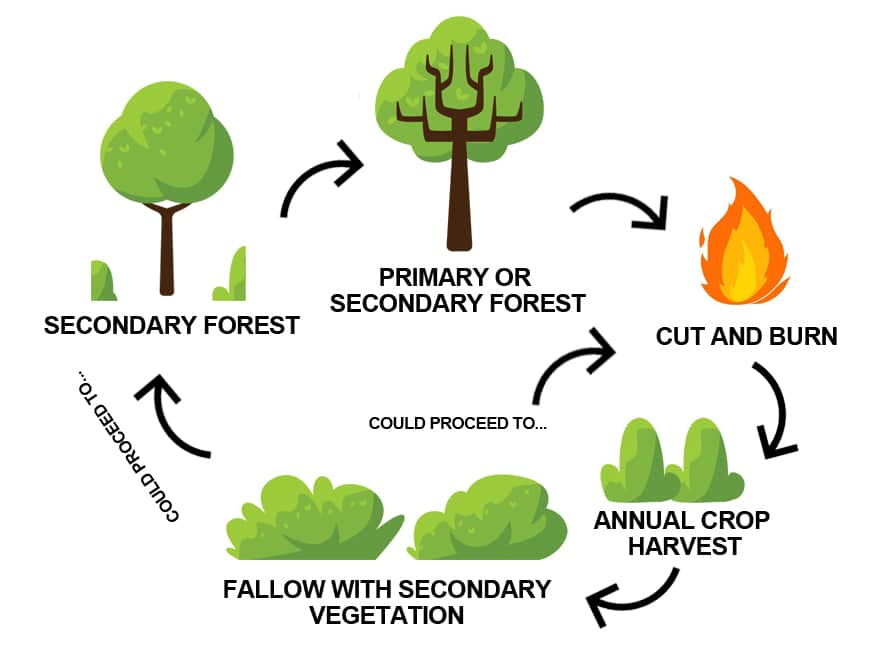
This practice is known by different name in different regions of India like:
- Jhum in Assam,
- Ponam in Kerala,
- Podu in Andhra Pradesh and Odisha and
- Bewar Masha Penda and Bera in various parts of Madhya Pradesh.
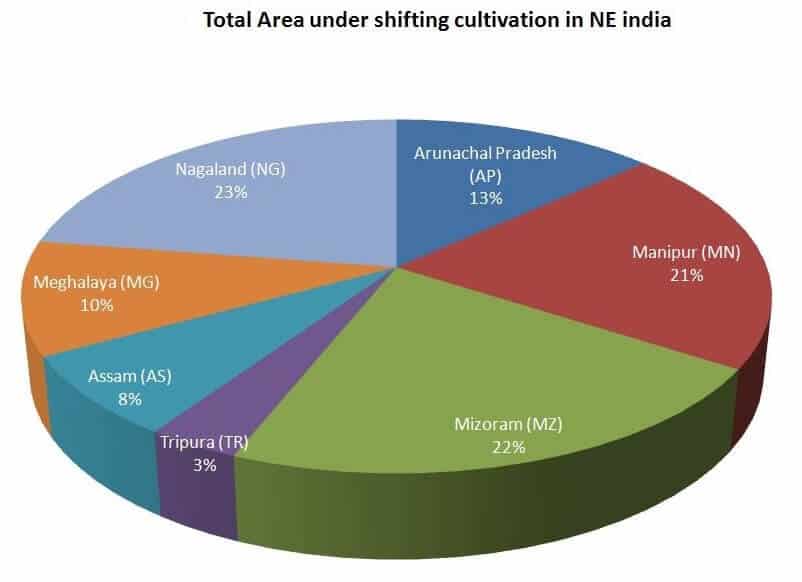
Crop Rotation
- Crop rotation is the reveres of land rotation (Shifting Cultivation)
- Crop rotation is the practice of planting different crops sequentially on the same plot of land to improve soil health, optimize nutrients in the soil, and combat pest and weed pressure.
- In crop rotation, there is repeated cultivation of crops and fallow land which is done in a certain sequence in a scientific manner to conserve the fertility of the land.
- For example, on a particular piece of land, in the first year we are sowing Malt-Barley in a sequence and in the second year Spring-Wheat in a sequence and in the third year we are sowing potatoes, and then again in the fourth year we are back to Malt – Barley sequence(refer the figure).
- Since the nutrient requirement of different crops are different, sowing different crops on the same piece of land in sequence and in a scientific manner maintains and even improves the soil fertility and stabilizes the income of farmers.
- Crop rotation checks the soil erosion and conserves moisture. It is because there is always some crop thriving on the land to check erosion of the topsoil.
- Suitable crop rotation is the key of modern scientific agriculture which aims to produce maximum yield by maintaining soil productivity.
Sustainable Agriculture/Eco-Farming
- The concept of sustainable agriculture has come up because yields from modern farming techniques reaching a plateau and the environmental problems due to excessive use of chemicals and fertilizers and pesticide residue in the food chain. The high use of modern farming techniques has led to the degradation of land and has led to various ecological problems like eutrophication, land degradation, etc., which has depleted the quality of land as a sustainable resource.
- Hence, we need a system of agriculture which produces sufficient food to meet the needs of the present generation without eroding the ecological assets and productivity of life supporting systems of the future generation.
- The table depicted below throws light on the fact that in sustainable agriculture the quantity of Input is low and output is high, thereby keeping the requirements of conservation of soil and increasing land productivity.

- Sustainable agriculture is a system of cultivation with the use of manures, Crop rotation, and minimal tillage. Some of the practices in Sustainable Agriculture are depicted in fig:

- Sustainable agriculture also involves agroforestry (growing trees near the crops), multi-level cultivation (growing trees of different heights in sequence), and integrated animal husbandry (growing crops with animal rearing practices).
- The term sustainability denotes the characteristic of a process that can be maintained indefinitely. Herewith the help of sustainable farm practices, the needs of the present generation can be met out without compromising the needs of future generations.
Zero Tillage farming/No-Till Farming
Tillage
- Tillage is an agricultural land preparation through mechanical agitation which includes digging, stirring, and overturning.
Zero Tillage
- Zero tillage is the process where the crop seed will be sown through drillers without prior land preparation and disturbing the soil where previous crop stubbles are present.
- Zero tillage not only reduces the cost of cultivation it also reduces the soil erosion, crop duration, and irrigation requirement, and weed effect which is better than tillage.
- Zero tillage (ZT) also called No-Tillage or Nil Tillage.
- No-till farming decreases the amount of soil erosion tillage causes in certain soils, especially in sandy and dry soils on sloping terrain.
- No-till farming is widely used in the United States and the number of acres managed in this way continues to grow. This growth is supported by a decrease in costs. No-till management results in fewer passes with equipment and the crop residue prevent evaporation of rainfall and increase water infiltration into the soil.
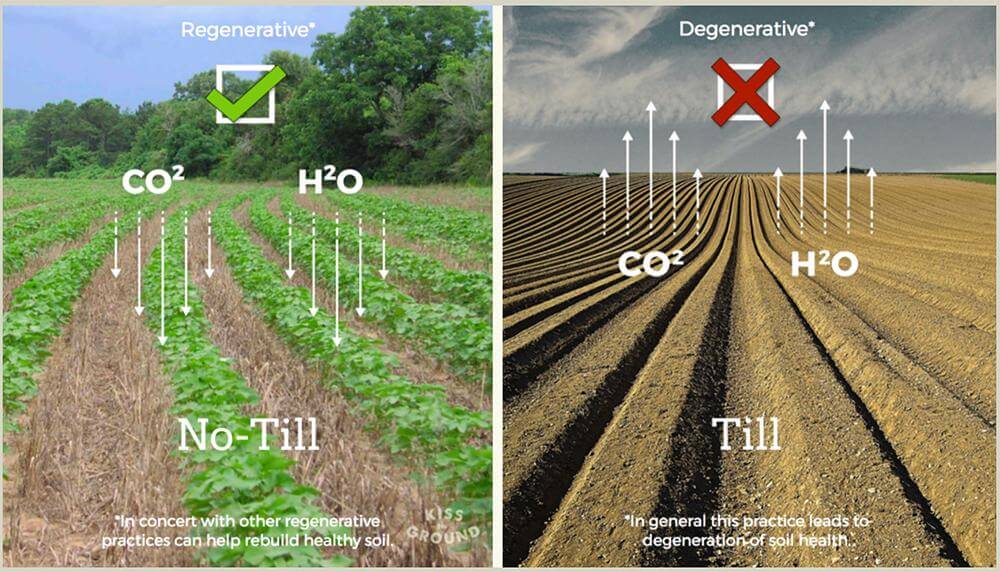
Advantages of zero tillage
- Reduction in the crop duration and thereby early cropping can be obtained to get higher yields.
- Reduction in the cost of inputs for land preparation and therefore a saving of around 80%.
- Residual moisture can be effectively utilized and the number of irrigations can be reduced.
- Dry matter and organic matter get added to the soil.
- Environmentally safe – Greenhouse effect will get reduced due to carbon sequestration.
- No-tillage reduces the compaction of the soil and reduces the water loss by runoff and prevents soil erosion.
- As the soil is intact and no disturbance is done, No-Till lands have more useful flora and fauna.
- This practice has carbon-sequestration potential. Apart from reducing carbon emission, the no-tilling practice can also reduce nitrous oxide emissions by 40 to 70%.
Disadvantages of Zero Tillage Farming
- the initial cost of zero tillage equipment (the upfront costs can be high, but they should be recouped through higher crop yields and fuel and labor savings)
- gullies can form in the fields (low-pressure tires and changing traffic patterns across the field can help prevent these)
- increased use of herbicides
- the learning curve for zero tillage farming
Zero budget natural farming (ZBNF)
- Zero Budget Natural Farming, a type of farming that involves the elimination of chemical pesticides, sustaining agriculture with eco-friendly processes, and restoring soil fertility and organic matter.
- It is a unique chemical-free method that involves agroecology. For the zero-net expenditure of manufacturing, yields are known as the term zero budget.
- ZBNF reduces farming expenses and promotes the use of natural fertilizers, biological pesticides, and local seeds.
Benefits of Zero Budget Natural Farming (ZBNF):
- As both a social and environmental program, it aims to ensure that farming – particularly smallholder farming – is economically viable by enhancing farm biodiversity and ecosystem services.
- It reduces farmers’ costs by eliminating external inputs and using in-situ resources to rejuvenate soils, whilst simultaneously increasing incomes, and restoring ecosystem health through diverse, multi-layered cropping systems.
- Cow dung from local cows has proven to be a miraculous cure to revive the fertility and nutrient value of soil. One gram of cow dung is believed to have anywhere between 300 to 500 crore beneficial micro-organisms. These micro-organisms decompose the dried biomass on the soil and convert it into ready-to-use nutrients for plants.
- Zero budget natural farming requires only 10 percent water and 10 percent electricity than what is required under chemical and organic farming. ZBNF may improve the potential of crops to adapt to and be produced for evolving climatic conditions.
Four wheels of ZBNF to be implemented in practically:
The “four wheels” of ZBNF are ‘Jiwamrita’, ‘Bijamrita’, ‘Mulching’ and ‘Waaphasa’, says Palekar, a Padma Shri awardee.
- Jiwamrita is a fermented mixture of cow dung and urine (of desi breeds), jaggery, pulses flour, water, and soil from the farm bund. This isn’t a fertilizer, but just a source of some 500 crore micro-organisms that can convert all the necessary “non-available” nutrients into “available” form.
- Bijamrita is a mix of desi cow dung and urine, water, bund soil, and lime that is used as a seed treatment solution prior to sowing.
- Mulching, or covering the plants with a layer of dried straw or fallen leaves, is meant to conserve soil moisture and keep the temperature around the roots at 25-32 degrees Celsius, which allows the microorganisms to do their job.
- Waaphasa, or providing water to maintain the required moisture-air balance, also achieves the same objective.
| S.No. | Zero Budget Natural Farming(ZBNF) | Organic Farming |
| 1. | No external fertilizers are used in ZBNF. | Organic fertilizers such as compost, cow dung, and vermicompost are used in organic farming. |
| 2. | There is no tilling and no mixing. It requires natural ecosystems. | It requires basic agro methods like tilling, plowing, mixing, etc. |
| 3. | It is low-cost farming due to the local biodiversity. | It is expensive due to the need for bulk manures. |
Subsistence Farming
- Subsistence agriculture occurs when farmers grow food crops to meet the needs of themselves and their families on smallholdings. Subsistence agriculturalists target farm output for survival and for mostly local requirements, with little or no surplus.
- Majority of farmers in the country practice subsistence farming.
- It is characterized by small and scattered land holdings and the use of primitive tools.
- As the farmers are poor, they do not use fertilizers and a high-yielding variety of seeds in their fields to the extent they should do.
- Facilities like electricity and irrigation are generally not available to them.
- The whole family works on the farm. Most of the work is done manually.
- The farms are small. Yield is not very high, Most of the yield is consumed by the family with a very little surplus for the family.
Plantation Agriculture
- Plantation agriculture is a type of commercial farming in which a single crop is grown for the entire year.
- The major crops grown during plantation agriculture are Tea, coffee, sugarcane, cashew, rubber, banana, or cotton.
- Major plantations are found in the tropical regions of the world. Plantations exist on every continent possessing a tropical climate.
- Rubber in Malaysia, coffee in Brazil, Tea in India, and Sri Lanka.
- It is capital intensive and demands good managerial ability, technical know-how, sophisticated machinery, fertilizers, irrigation, and transport facilities. Plantation agriculture is export-oriented agriculture.
Dryland, and Wetland farming
Dryland farming
- They are practiced in the region receiving low rainfall, like Rajasthan, some parts of Gujarat and Maharashtra, etc. The soil is sandy and has low water retention capacity.
- Crops like Peas, millets, grams, and other drought-resistant crops or varieties can be grown.
- Dryland farming helps in soil and water conservation.
Wetland Framing
- It is practiced in the regions receiving high annual rainfall, mainly done in river plains, north-east India, the Ghats of India, etc. Crops requiring high irrigation can be easily grown.
- Types of crops under wetland farming in India are Rice, sugarcane, cotton, Jute, etc.
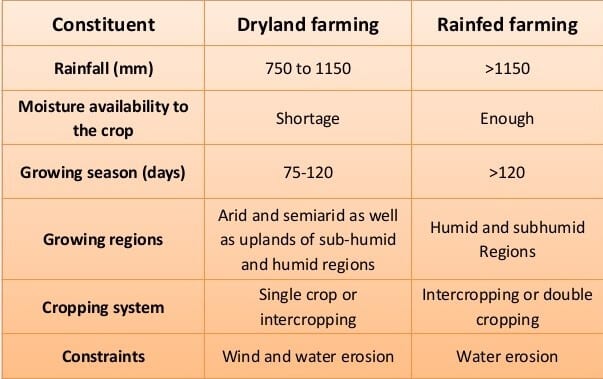
Terrace Cultivation
- The hill and mountain slopes are cut to form terraces and the land is used in the same way as in permanent agriculture.
- Since the availability of flat land is limited terraces are made to provide a small patch of level land.
- Soil erosion is also checked due to terrace formation on hill slopes.
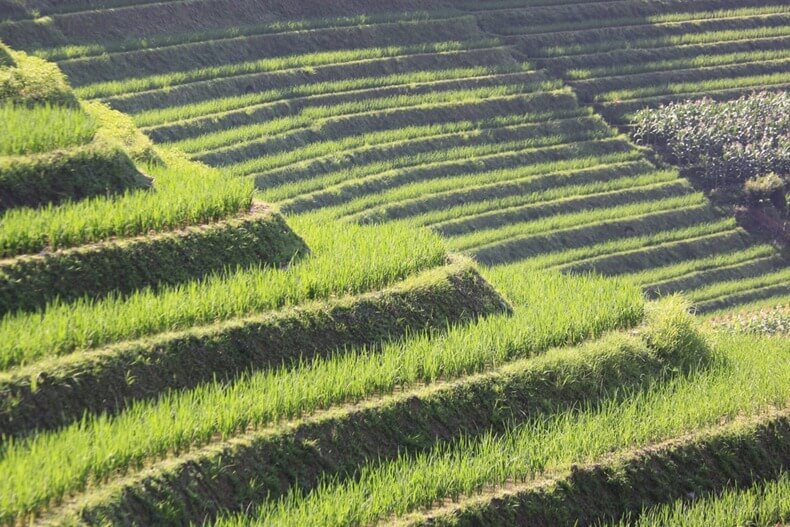
| Agricultural Production (India’s Position in World Agriculture) |
|---|
| Largest producer of milk. |
| Largest producer of millets in the world |
| Largest producer of jute. |
| Largest producer of ginger. |
| Largest producer of bananas. |
| Largest producer of castor oil seeds. |
| Largest producer of mangoes. |
| Largest producer of safflower oil seeds. |
| Largest producer of papayas. |
| Largest producer of cottonseed (As per International Cotton Advisory Committee (ICAC) report for the month of March 2017) |
| Second largest producer of tea, the first position being held by China. |
| Second largest producer of sugarcane, the first position being held by Brazil. |
| Second largest producer of wheat, the first position being held by China. |
| Second largest producer of onions, the first position being held by China. |
| Second largest producer of potatoes, the first position being held by China. |
| Second largest producer of garlic, the first position being held by China. |
| Second largest producer of rice, the first position being held by China. |
| Second largest producer of cement., next to China. |
| Second largest producer of silk, the first position being held by China. |
| NOTE: The agricultural information is as per the latest data available on the website of the Food and Agricultural Organisation. |

To the point and relevant article
Thanks, guys. keep reading
Plz provide total gs notes upsc
thanx sir for exceptional articles with current data.
great job .,, fantastic explanation ……GOD BLESS YOU
Thanks
Sir pls make notes on NDA &CDS syllabus for this websites because I am NDA aspirant and I write notes of UPSC IAS. May be it’s very hard to new and other aspirant. So pls
Thank you so much for all the work you guys do.
No Matter What Sir Please Don’t Ever Stop This Initiative … Sooner or later People Will See The difference and will recognise your efforts and This Will Grow !!💯💯
🧡
Thanks alot sir for your kind help…i am so much delighted to say that it’s very helpful to me in my journey of upsc…may god be with you and may this site get more fame and so many get benefited from this..🙏
Thanks Prince for your kind words 🧡
Really helpful. gratitude from the bottom of the heart.
A well structured content. Thanks @lotus team
Thanks for your all affords to provide such a meaningful and useful information 🙌
Keep Reading, Share with your Friends as well.
Amit sir thank you for the wonderful Content. Helpful.
I m searching many websites but it’s very helpful..thank u